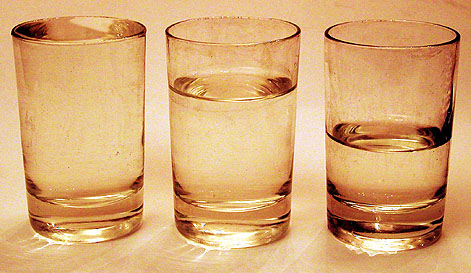Evaporation
Today, I learn from a water glass as I come out of sleep. The University of Houston's College of Engineering presents this series about the machines that make our civilization run, and the people whose ingenuity created them.
I was half waking, half sleeping this morning -- still in bed, worrying about troubles abroad in the land. I found myself staring at the glass on my nightstand. The water level was, of course, dropping, but it drops far too slowly for anyone to see movement. In a week, I suppose, the water might evaporate away entirely.
Just above the water surface is a mixture of air and water vapor that happens to be 38 molecules of air for each molecule of water. As long as they stay in that proportion, the vapor above and the liquid below are in equilibrium, and no evaporation can take place. But nature has means for clearing out the water vapor, so evaporation can continue. Since the molecules stay in constant motion, bouncing off one another, the vapor in the air near the surface gradually stirs itself outward. More water then evaporates from the surface to sustain the equilibrium.
All the air around us contains water. The more it contains, the slower the outward diffusion of evaporated molecules. In a humid climate, water will stay in the glass for many days. Out in the Sahara, it might be gone overnight.
So consider the extreme case: Imagine that you could magically find a way to remove every water molecule as it left the surface. Think about evaporation, totally unimpeded by that milling gaggle of molecules. I did the calculation, and found that, if you could instantly clean away every new water vapor molecule, the level in your bedside glass would begin falling at the astonishing rate of four inches per second. And, even if you could do that, nature would then call other thermal forces into play to slow evaporation.
All this helps me keep my equanimity in these too-often-troubled times. As we read the headlines, we get the impression that our world is about to fall into some abyss of chaos. So come back to that bedside glass: The water in it seemingly wants to whoosh away in seconds; but nature does not like catastrophic completions of its processes.
Iron would quickly rust away in the open air, but nature intervenes. Rust itself turns into a coating that protects steel girders or iron grillwork for centuries. The murderous disease of Ebola kills its hosts so quickly that it limits its own spread.
And terrorism: It may seem rampant today, but it creates such odium, and calls up such resistance, that it's self-limiting in exactly the same way as rust, evaporation, or Ebola.
Catastrophe does occur, of course. Disease and terrorism do kill. Now and then a structural member rusts out, and a building falls. The cat might jump up on my nightstand and knock my water glass to the floor. But our direst expectations are very seldom met, for the remarkable reason that nature is ultimately our friend. And, as long as we don't systematically mistreat her, she looks after us far better than we might first think.
I'm John Lienhard, at the University of Houston, where we're interested in the way inventive minds work.
(Theme music)
What I have done here is to provide illustrations of the thermodynamic principle of Le Chatelier and Braun, which says that all spontaneous processes call up resistance to their own completion. (See Episode 1564.)
The principle is especially well described in Epstein, P.S., Textbook of Thermodynamics. New York: John Wiley & Sons, Inc., 1937, Chapter 21; and in Callen, H.G., Thermodynamics and an Introduction to Thermostatistics. New York: John Wiley & Sons, 1985, Sections 8.4 and 8.5.

photo by John Lienhard